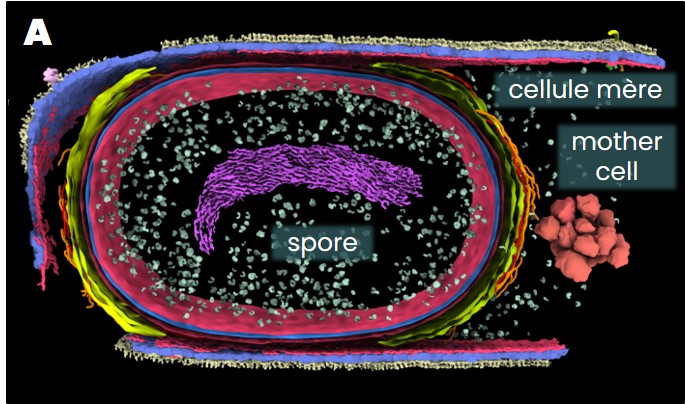Under stress condition, some bacteria can form spores, structures that correspond to a state of dormancy. These spores are able to resist several stresses, such as exposure to antibiotics, disinfectants, irradiation or high temperatures. These properties can be advantageous (probiotics), or raise a public health, food safety or bioterrorist threat when spores of pathogenic bacteria are involved. The resistance of spores is achieved by intracellular (e.g. crystalline structure of the chromosome) and extracellular (e.g. thick protein coat) assemblies that protect the cell and its genetic material. The structure and nature of these assemblies remain to be elucidated in detail.
In order to study the formation of the spore's protective structures, researchers at IRIG, in collaboration with the ESRF synchrotron in Grenoble and the Central European Institute of Technology in the Czech Republic, analyzed spore-forming bacteria using cryo-electron tomography, carried out on lamellae of cells obtained using ion beams at cryogenic temperature (cryo-FIB).
This work revealed that during the development of the spore, the chromosome forms a torus of nanofibres and that the coat proteins are deposited in layers of distinct composition and architecture.

This work has initiated a high-resolution study of the macromolecules essential to spore formation, providing a better understanding of their exceptional resilience.
Fundings
- ANR (FRISBI project) and doctoral school of the University of Grenoble Alps (UGA) (GRAL project)
- Auvergne-Rhône-Alpes Region
- Medical Research Foundation (FRM)
- FEDER
- GIS- Biology, Health and Agronomy infrastructures
- MEYS CR and the European Regional Development Fund (UP project)
- The European Commission's Horizon 2020 programme (Instruct-ERIC and iNEXT-Discovery)
Collaborations
- ESRF Grenoble
- Central European Institute of Technology (Czech Republic)
- Centre Instruct-CZ (Czech Republic)